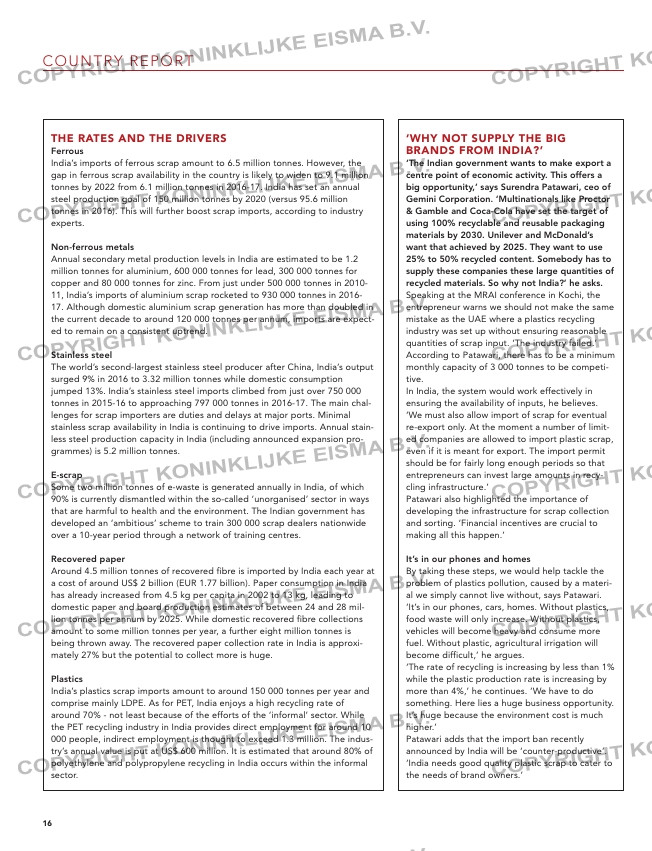Page 16 from: New issue out now!

COUNTRY REPORT
16
the rates and the driVers
Ferrous
India’s imports of ferrous scrap amount to 6.5 million tonnes. However, the
gap in ferrous scrap availability in the country is likely to widen to 9.1 million
tonnes by 2022 from 6.1 million tonnes in 2016-17. India has set an annual
steel production goal of 150 million tonnes by 2020 (versus 95.6 million
tonnes in 2016). This will further boost scrap imports, according to industry
experts.
Non-ferrous metals
Annual secondary metal production levels in India are estimated to be 1.2
million tonnes for aluminium, 600 000 tonnes for lead, 300 000 tonnes for
copper and 80 000 tonnes for zinc. From just under 500 000 tonnes in 2010-
11, India’s imports of aluminium scrap rocketed to 930 000 tonnes in 2016-
17. Although domestic aluminium scrap generation has more than doubled in
the current decade to around 120 000 tonnes per annum, imports are expect-
ed to remain on a consistent uptrend.
Stainless steel
The world’s second-largest stainless steel producer after China, India’s output
surged 9% in 2016 to 3.32 million tonnes while domestic consumption
jumped 13%. India’s stainless steel imports climbed from just over 750 000
tonnes in 2015-16 to approaching 797 000 tonnes in 2016-17. The main chal-
lenges for scrap importers are duties and delays at major ports. Minimal
stainless scrap availability in India is continuing to drive imports. Annual stain-
less steel production capacity in India (including announced expansion pro-
grammes) is 5.2 million tonnes.
E-scrap
Some two million tonnes of e-waste is generated annually in India, of which
90% is currently dismantled within the so-called ‘unorganised’ sector in ways
that are harmful to health and the environment. The Indian government has
developed an ‘ambitious’ scheme to train 300 000 scrap dealers nationwide
over a 10-year period through a network of training centres.
recovered paper
Around 4.5 million tonnes of recovered fibre is imported by India each year at
a cost of around US$ 2 billion (EUR 1.77 billion). Paper consumption in India
has already increased from 4.5 kg per capita in 2002 to 13 kg, leading to
domestic paper and board production estimates of between 24 and 28 mil-
lion tonnes per annum by 2025. While domestic recovered fibre collections
amount to some million tonnes per year, a further eight million tonnes is
being thrown away. The recovered paper collection rate in India is approxi-
mately 27% but the potential to collect more is huge.
Plastics
India’s plastics scrap imports amount to around 150 000 tonnes per year and
comprise mainly LDPE. As for PET, India enjoys a high recycling rate of
around 70% – not least because of the efforts of the ‘informal’ sector. While
the PET recycling industry in India provides direct employment for around 10
000 people, indirect employment is thought to exceed 1.3 million. The indus-
try’s annual value is put at US$ 600 million. It is estimated that around 80% of
polyethylene and polypropylene recycling in India occurs within the informal
sector.
‘why not supply the Big
Brands from india?’
‘the Indian government wants to make export a
centre point of economic activity. this offers a
big opportunity,’ says Surendra Patawari, ceo of
Gemini Corporation. ‘Multinationals like Proctor
& Gamble and Coca-Cola have set the target of
using 100% recyclable and reusable packaging
materials by 2030. unilever and McDonald’s
want that achieved by 2025. they want to use
25% to 50% recycled content. Somebody has to
supply these companies these large quantities of
recycled materials. So why not India?’ he asks.
Speaking at the MRAI conference in Kochi, the
entrepreneur warns we should not make the same
mistake as the UAE where a plastics recycling
industry was set up without ensuring reasonable
quantities of scrap input. ‘The industry failed.’
According to Patawari, there has to be a minimum
monthly capacity of 3 000 tonnes to be competi-
tive.
In India, the system would work effectively in
ensuring the availability of inputs, he believes.
‘We must also allow import of scrap for eventual
re-export only. At the moment a number of limit-
ed companies are allowed to import plastic scrap,
even if it is meant for export. The import permit
should be for fairly long enough periods so that
entrepreneurs can invest large amounts in recy-
cling infrastructure.’
Patawari also highlighted the importance of
developing the infrastructure for scrap collection
and sorting. ‘Financial incentives are crucial to
making all this happen.’
It’s in our phones and homes
By taking these steps, we would help tackle the
problem of plastics pollution, caused by a materi-
al we simply cannot live without, says Patawari.
‘It’s in our phones, cars, homes. Without plastics,
food waste will only increase. Without plastics,
vehicles will become heavy and consume more
fuel. Without plastic, agricultural irrigation will
become difficult,’ he argues.
‘The rate of recycling is increasing by less than 1%
while the plastic production rate is increasing by
more than 4%,’ he continues. ‘We have to do
something. Here lies a huge business opportunity.
It’s huge because the environment cost is much
higher.’
Patawari adds that the import ban recently
announced by India will be ‘counter-productive’.
‘India needs good quality plastic scrap to cater to
the needs of brand owners.’
14-15-16-18-19-20-22-23_countryreport-india.indd 16 14-03-19 09:55



